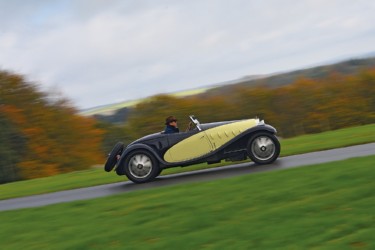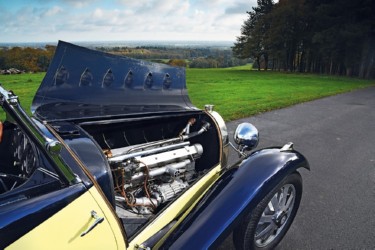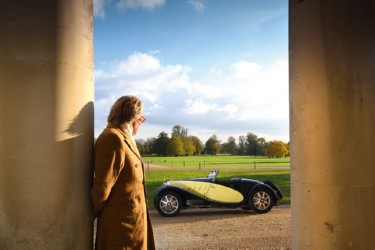|
Original Title: Bugatti Type 55: a Bug’s life
 Few beautiful pre-war sports cars have lived such rich and dramatic lives as this unique Figoni-bodied Bugatti Type 55.
Few beautiful pre-war sports cars have lived such rich and dramatic lives as this unique Figoni-bodied Bugatti Type 55.
Originally built to challenge Alfa Romeo at Le Mans, it was later rebodied by one of the greatest French coachbuilders, and wowed all at concours events through the 1930s.
Hidden away during WW2, it was discovered in the early ’60s and saved by Geoffrey Stuart St John, one of the most respected English Bugatti connoisseurs.
Once rebuilt, the seductive 110mph roadster was driven all over Europe covering thousands of miles each year, more than any other of the 38 twin-cam exotics built.
Until his passing in February 2019, aged 88, St John enjoyed 56 years of rewarding ownership with the two-tone beauty.
After a horrific crash in France, he rebuilt the car and again it claimed concours glory.
He was a hands-on Bugatti owner in the old-school style, delighting in maintaining, restoring, driving and racing his machines, as well as guiding others in matters Molsheim right up to his last months.
On sunny days in his final years, the Figoni Type 55 was regularly seen parked at The Bugatti Trust, of which he was a dedicated supporter.


St John has been one of my heroes as a vintage racer since I was a lad visiting Prescott, and his much-driven Type 55 remains one of my favourite Bugattis.
But when it was first built this rakish machine looked very different, because it was conceived as a long-distance sports-racing car.
After Bugatti’s disastrous 1931 Le Mans attempt with the pair of mighty Type 50 works cars, Ettore entered two new Type 55 racers for the 1932 event.
To avoid any adverse publicity, however, the new cars were registered to the private teams of Count Guy Bouriat and the wealthy Polish aristocrat Stanislaus Czaykowski. Only if they were successful would Le Patron claim involvement.
 The functional-looking tourers couldn’t be further removed from the glamorous coachbuilt T55 road cars.
The functional-looking tourers couldn’t be further removed from the glamorous coachbuilt T55 road cars.
Clearly prepared by the factory, they followed the style of the T50 – fabric-covered rear body, cycle wings, side-mounted spare and the petrol tank slung under the back with toolbox mounted above.
An extra spotlight, aeroscreens and additional wing stays were added for the 24-hour enduro. For the fast straights, the cars were fitted with long 3.86:1 rear-axle ratios, and extra fuel-tank straps.
The favourite of the two cars was chassis 55221, driven by Bouriat teamed with works ace Louis Chiron, the fast and dashing Monégasque.
 From practice the Type 55s were no match for the dominant Alfa Romeo 8Cs, however, and at the start the two experienced racers set a steady pace, with first driver Chiron lying seventh and the veteran Ernest Friderich in ninth.
From practice the Type 55s were no match for the dominant Alfa Romeo 8Cs, however, and at the start the two experienced racers set a steady pace, with first driver Chiron lying seventh and the veteran Ernest Friderich in ninth.
When three Alfas crashed, the Bugattis moved up the leaderboard but on lap 23, while running fourth, Bouriat suddenly failed to appear.
Through the woods at Tertre Rouge the quickest Type 55 spluttered to a halt with an empty fuel tank.
A mystified Bouriat climbed out as a crowd gathered around the Gallic hopeful, who swiftly discovered the cause: a stone had wedged up between the rear axle and the petrol tank, chafing a hole and causing a fuel leak.


The other Type 55 motored on through the evening and by midnight Czaykowski and Friderich had moved up to fourth behind a trio of 8Cs.
As the sun rose, the blue challenger was up to third, but seven laps behind the Italians, and by midday after the leaders had been further delayed there even looked to be a chance of snatching second.
But Bugatti’s Le Mans jinx returned as Friderich’s car misfired to a stop at the exit of Arnage. A fractured oil pipe had caused piston failure and, although still listed as fourth on distance at the flag, the Bugatti wasn’t classified because it failed to finish.
Molsheim would have to wait another four years before the marque finally conquered La Sarthe with the spectacular Type 57G streamliners.
 Fresh from Le Mans, the tank was repaired and chassis 55221 was sold by Bouriat to Jacques Dupuy, a wealthy French magazine publisher.
Fresh from Le Mans, the tank was repaired and chassis 55221 was sold by Bouriat to Jacques Dupuy, a wealthy French magazine publisher.
After enjoying the Type 55’s formidable pace in its Le Mans guise, Dupuy decided to send it to Carrosserie Figoni in Boulogue-sur-Seine, where Italian-born founder Giuseppe ‘Joseph’ Figoni began creating one of his most beautiful and restrained designs for the Bugatti.
Best known for his flamboyant and glamorous coachwork, Figoni’s work was highly innovative in detail.
The one-off roadster was finished by 1933 and Dupuy proudly entered the 1933 Paris-Nice rally and won, proving that the gorgeous-looking but heavier new body style hadn’t hampered the car’s performance.
The rebodied Type 55 was a regular at French concours events throughout the 1930s, including the Bois de Boulogne in Paris where the crew dressed in natty two-tone nautical fashions together with a black Scottie dog to match the Bugatti’s colour scheme.
During the war, like so many exotics, the desirable car was hidden away from inquisitive occupying forces, and with peacetime it found its way down to the south of France.
Eventually the Type 55 followed a number of great Bugattis across La Manche to England where St John, then an engineer with Smiths Industries, first came across the car while searching for spares for his rapid Type 35B.
Having broken a wheel while racing at VSCC Oulton Park in 1962, St John called in at the garage of HH ‘Tom’ Thomas, who was well known for his stash of Bugatti spares, and spied the part-dismantled Figoni beauty for sale at £750.
Thomas maintained that this Type 55 was the best, but amazingly it was the car’s well-preserved wheels that first tempted St John, who had no idea of the car’s Le Mans history when he bought it in ’63.


The keen racer’s spare time was largely taken up preparing and racing his T35B, but he eventually focused on rebuilding the T55 and it was finally back on the road in ’67, the little-seen roadster causing a stir when it first appeared at Prescott Hill Climb.
When a Type 51 replaced his Type 35B, St John briefly fitted a towbar to the back of the Type 55 to haul his racer, the quad-cam equipe making an amazing sight striding out across the Cotswolds from his home workshop in Chedworth to Prescott, always with his stylish wife Rita by his side.
“It was a bit unkind to the Type 55,” reflected St John. “You can’t slip Bugatti dry-plate clutches, which is a problem when you’re faced with a slight incline and you have a ton of trailer on the back.”
 St John competed occasionally with the T55 in sprints and hillclimbs.
St John competed occasionally with the T55 in sprints and hillclimbs.
At Prescott he was regularly given number 55, but it was on the open road when touring across Europe that he and Rita found the car in its element.
Rarely was the roof raised, while the high doors with wind-up windows offered superior protection to the Jean Bugatti-styled factory car.
“The Type 55 is happiest on undulating, slightly winding French roads, where it can be up and ahead of most modern cars,” concluded St John.
Motorways were avoided because of the drum brakes, but St John maintained that the Bugatti’s limitations were mainly down to the narrow rubber rather than the design.
On long trips to overseas events the 2.3-litre, 140bhp straight-eight returned just 14mpg and, despite meticulous maintenance, the engine regularly threw out its Straight 50 oil.
“Bugattis are one of those terrible diseases,” St John told journalist Mark Gillies in 1989. “I just like the stubborn individualism. It’s always very pleasant to work on these cars and handle the parts. There just aren’t any comparisons.”
St John retired early from Smiths to focus on Bugattis, both his own projects and restoration for others.
His appreciation of fine engineering also embraced Velocette motorcycles and an 1892 Samuel & Co steam launch.
 In 1994 the T55 was involved in a shocking accident when St John was convoying across France to an Italian Bugatti rally with his good friend Rodney Felton’s Brescia.
In 1994 the T55 was involved in a shocking accident when St John was convoying across France to an Italian Bugatti rally with his good friend Rodney Felton’s Brescia.
The two cars were hit by an uninsured local, with Felton’s leading vintage voiturette coming off worse.
Once he had recovered, St John set about rebuilding his cherished car and it soon looked smarter than ever.
Although he wasn’t a concours man, I managed to tempt my hero to display the Figoni-bodied Bug in the Cartier Style et Luxe at the 1997 Goodwood Festival of Speed.
In spite of fierce competition in the Pre-War Supercharged Sports Car class, the judges were smitten by the T55, which was a resounding winner in the final vote for Best of Show.
None were more surprised than Rita and Geoffrey when they were called up to collect the award.
During the weekend we had plenty of time to chat as we sheltered from the rain.
When I mentioned the Earl of March’s passion for Bugattis, St John said he would be happy to offer the event’s founder a drive, but frustratingly we never managed to get everyone together at Goodwood for the informal run.
St John died in February 2019, and for months I wondered about the fate of one of my all-time favourite cars.
When Bonhams announced that the Type 55 would be the star of its Grand Palais Paris auction on 6 February this year, I suggested to director Sholto Gilbertson the idea of finally sorting a drive for the Earl, now the Duke of Richmond.
The plan found enthusiastic approval and on a beautiful autumn day the Figoni roadster returned to Goodwood House, 22 years after it won the Cartier Style et Luxe.


Parked in the sunshine in front of the Palladian-style frontage, the exotic Bugatti looks right at home.
Finding a window in his packed schedule was a challenge, but the enthusiastic Duke was determined not to miss the opportunity of a drive in the T55.
Bugattis have been a fascination for him from an early age, and back in 2000 he tested a Type 51 up the famous hillclimb that forms his driveway.
“I loved coming down to Goodwood to see my grandparents, who were the most wonderful characters,” he recalls.
“When I was eight, they gifted me a copy of Ralph Stein’s book The Great Cars. I spent all of Easter trying to draw the Bugattis it illustrated. The style and details of these amazing machines still captivate me.”
 Since the launch of the Festival of Speed and the subsequent reopening of the circuit for the Revival, Goodwood has hosted some remarkable marque highlights including a display of five Royales in 2007, and the largest-ever Bugatti-only grid at the 2014 Members’ Meeting.
Since the launch of the Festival of Speed and the subsequent reopening of the circuit for the Revival, Goodwood has hosted some remarkable marque highlights including a display of five Royales in 2007, and the largest-ever Bugatti-only grid at the 2014 Members’ Meeting.
Coincidently, just inside the house, a Baby Bugatti has indoctrinated another generation: “My three-year-old grandson adores it.”
Outside, the Duke slowly walks around the Type 55 and Figoni’s sleek body, with its elegant detailing, immediately enthralls him.
“The shape is exquisite and the lines really flow,” he enthuses, his hands moving to acknowledge the profile and neat tail design. “The low windscreen perfectly finishes off its style and reminds me of a classic ’32 hot rod.”
After glancing inside at the bench seat, he finally climbs in for a drive up the familiar strip of Tarmac.
The clockwork-style key is pressed in and the straight-eight immediately barks into life with a glorious, rousing rasp: “The throttle is super-responsive and I love the fantastic blend of sounds the engine plays. There’s nothing quite like a Bugatti exhaust note.”
The Duke is fortunately well prepared for the tight footwell, having worn narrow shoes, but the centre throttle comes as a surprise.
After practice he declares the layout better for heel-and-toeing and marvels at the feel of the controls, particularly the light, short clutch action.


Having familiarised himself with the reversed gate of the modified constant-mesh ’box, first is engaged and the Duke moves around the gravel circle in front of the house and on to the blacktop.
Quickly into second, the Bugatti accelerates up the hill, its crisp, throaty exhaust audible long after the car has vanished up the tree-lined route to Molecomb corner.
After several runs the Type 55 returns, autumn leaves caught in the distinctive honeycomb radiator core and the black paint dulled by light grime.
“It’s beautiful to drive,” the Duke smiles as he switches it off. “The steering is as light and sharp as the T51 GP car I drove here, and the torque is marvellous.
“The engine feels wonderfully smooth right through the rev range, and the gearchange is much faster than my AC 16/80. I’m amazed at how tight the whole car feels.”
Clearly delighted by the diversion from a busy schedule, the Duke reluctantly has to go.
For a few more minutes before historic racing specialist Dan Setford arrives with the trailer, we stand and admire the T55 in the late sun.
As he loads up, Setford concludes: “I just hope the next owner uses it. Too many great cars are now being stuck away.”
On such a beautiful afternoon, it’s frustrating that I can’t drive the Bugatti back over the South Downs into the sunset.
That’s what St John would have done, with Rita by his side and the elegant Scintilla headlights illuminating the road as darkness crept in on the way back to his beloved Cotswolds.


Images: Will Williams (except for the B&W one, which is from the BugattiRevue Archives)
Thanks to the Duke of Richmond, Setford & Company and Bonhams
| 

